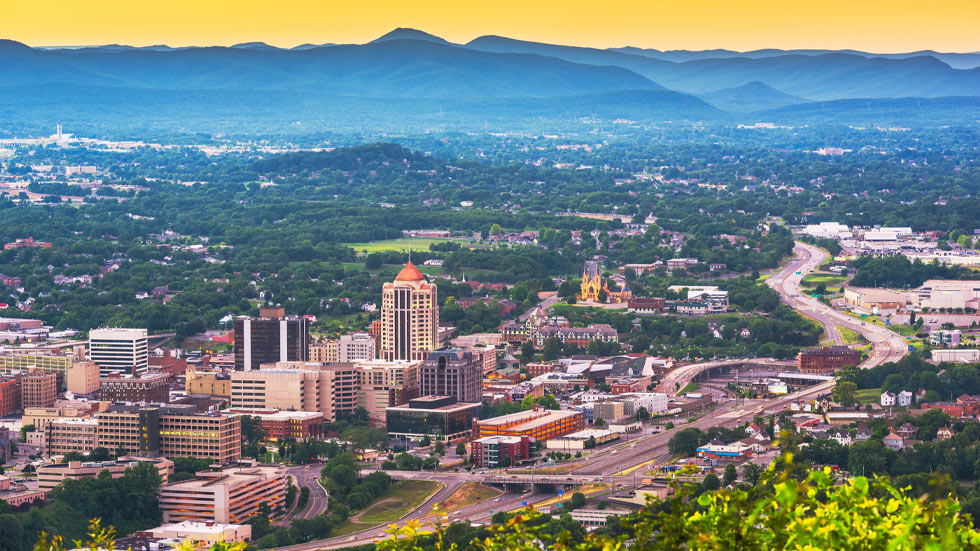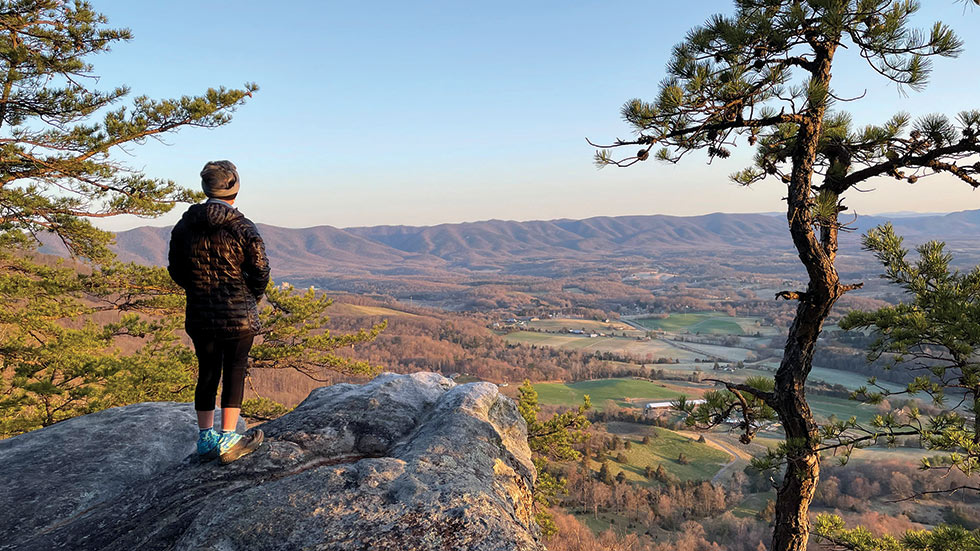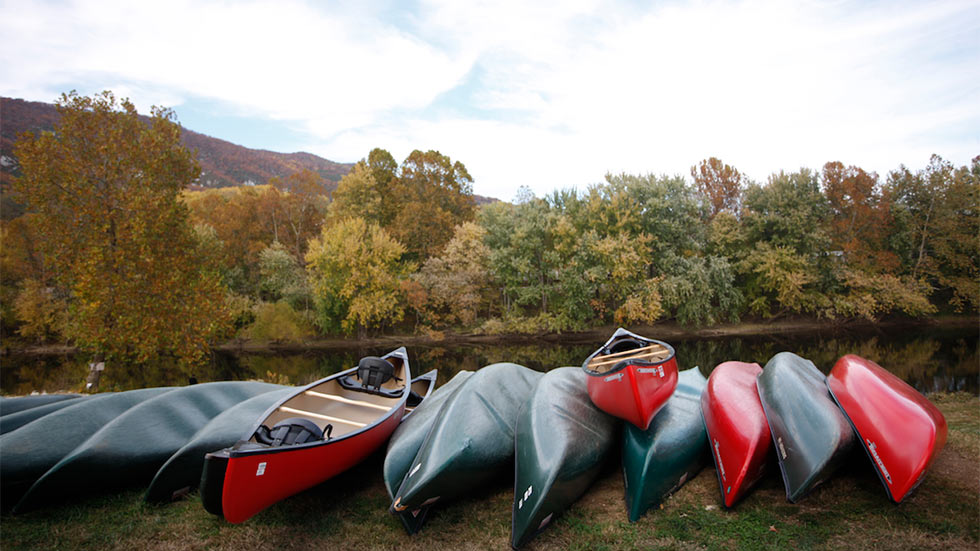Blue Ridge Mountain High
The Greater Roanoke Region in Southwestern Virginia offers a bevy of outdoor adventure sports











Former lawyer Jeff Todd and his wife, Bethany, escaped the “rat race” of DC eight years ago and headed West, hoping to find a more relaxed lifestyle in Denver, Colorado. They did, indeed, discover a new way of life there, one focused largely on enjoying the outdoors. But it took a move back East to Roanoke, Virginia, five years ago for the Todds to realize that Colorado doesn’t have a monopoly on mountain scenery and the active lifestyle.
“I’m originally from Virginia, but I’d just never looked at the state that way. Moving back to this area, I realized that we have awesome mountains right here, and they’re so much more accessible than they were in Denver,” says Todd, who owns outdoor equipment outfitter Roanoke Mountain Adventures. “In Denver you have to drive a distance to get to the mountains, and you have to prepare for enhanced risks and the highly variable weather of a high-altitude environment. Virginia generally offers a tamer and more predictable environment. “There’s grand scenery out West, of course, but here in southern Virginia, we’re 20 minutes from trailheads that lead to some of the most iconic spots on the Appalachian Trail, and there’s peaceful flat-water paddling and all sorts of water sports. And then, boom, you can be right back downtown to go grab a beer or dinner or go back to your hotel or whatever,” adds Todd.

Downtown Roanoke
THE HUB AND ITS SPOKES
It’s that city-surrounded-by-outdoor-paradise experience the local tourism bureau seeks to capitalize on by marketing Virginia’s Blue Ridge region as a “metro mountain destination.” The metro at the heart of it all is Roanoke, with a population just shy of 100,000, an art museum, a photography museum, a transportation museum, a children’s museum, and a compact downtown alive with galleries, shops and restaurants—not to mention a growing number of craft breweries and distilleries.
And the mountain paradise? That would be the Blue Ridge Mountains, a subsection of the Appalachian Mountains that extends from Pennsylvania to Georgia and gets its moniker from the distinctive hue of the mountains when seen from a distance (a result of hydrocarbons released into the air by the forests).
As the largest city in Virginia’s Blue Ridge, Roanoke has easy access to a host of wilderness areas where outdoor lovers can commune with nature and get back in time for dinner. And for those with no need for city life, there are camping options aplenty.

Roanoke Appalachian Trail Club member Donna Logan looks out across Daleville, Virginia, from a vantage point on the Appalachian Trail. Photo courtesy of Donna Logan.
HIKING THE HILLS
The greater Roanoke region sits at the nexus of the 1.8-million-acre George Washington and Jefferson National Forest; the Appalachian Trail (AT), with 120 miles of trail passing through; and the famed Blue Ridge Parkway, a two-lane mountaintop road offering up vista after vista as it twists and turns for 469 miles from Shenandoah National Park in Virginia to Great Smoky Mountains National Park in North Carolina.
Although many people think of the parkway as an auto-touring route, hiking trails can be accessed all along its length. Combine hiking trails in these national lands with those in the five state parks and numerous county and city parks, and the tally rises to 600 miles of hiking trails within an hour’s drive of Roanoke.
Most every week, you’ll find local Donna Logan on the McAfee Knob trail. A member of the Roanoke Appalachian Trail Club, she’s on a task force that provides upkeep for this popular section of the AT. Although she has through-hiked the AT once and will complete a multiyear section hike of the AT this summer, Logan has an affinity for hiking trails in the Roanoke region—and not just because they’re nearby.
“McAfee Knob is just beautiful. It’s the most photographed spot on the AT; it’s been written up many times in magazines. People come from all over Virginia and other states—I met a couple the other day from Indiana, others from Ohio—just to do this hike,” she says.
A moderately strenuous 4.4-mile hike up Catawba Mountain leads to the dramatic knob, an overhang 3,197 feet above sea level that offers stunning panoramic views and serves as the backdrop for innumerable selfies.
Many McAfee Knob hikers combine the trek with hikes to Tinker Cliffs and the spear-like Dragon’s Tooth to complete Virginia’s vaunted 35-mile Triple Crown Loop.
The region offers plenty of less daunting hikes, too, including some that lead to waterfalls, others that meander along waterways, and still others that pass through fragrant pine forest.
Todd says he and his three children (age 3, 7 and 10) frequently hike the trails at Roanoke’s 568-acre Mill Mountain Park. “One of my kids’ favorite thing to do is to go up to the star [the 88-foot-tall neon star topping Mill Mountain that is the emblem of Roanoke],” he says. “It’s a natural playground up there. We do the trails, visit the nature center, and see the wildflower garden and the zoo.”

Avid mountain bikers travel to southern Virginia to cycle the 60 miles of trails at Carvins Cove Natural Reserve. Photo by Sam Dean Photography, courtesy of Visit Virginia's Blue Ridge
BIKING TRAILS FROM EASY TO DIFFICULT
The region has equal cred with cyclists—particularly for its mountain biking trails. Three years ago, the International Mountain Biking Association named Virginia’s Blue Ridge a Silver-Level Ride Center—one of only 15 Silver-Level Centers in the world and the highest designation achieved by any region on the East Coast. Its status puts Roanoke on par with mountain-biking destinations such as Steamboat Springs, Colorado, and Sun Valley, Idaho. The recognition comes not just for the region’s network of 300 miles of trail but also for its supportive mountain biking community and the fun to be had beyond the trails.
Carvins Cove Natural Reserve— comprising nearly 13,000 acres of woods surrounding Roanoke’s reservoir—is legendary among mountain bikers for its 60 miles of multi-use trails that range from Easy (such as the appropriately named Happy Valley) to Extremely Difficult (Rattlin’ Run and Gauntlet).
Douthat State Park in Milltown also ranks highly for its 43 miles of trails dipping into hollows, climbing mountains, and running along creeks and waterfalls. Intermediate riders will find the mountain biking trail system at Mill Mountain a perfect fit.
At the other end of the biking scale are casual riders peddling along the paved 14-mile-long Roanoke River Greenway, many of them families with kids in tow riding bikes or trikes.
“There’s a good bike scene here, and you can pretty much do it all: road biking, mountain biking, trails,” says Rouselle Ligon, operations manager for Roanoke Mountain Adventures. “And if you want to do a group ride, there are always people you can meet up with.”
Riders often congregate at Starr Hill Pilot Brewery in Roanoke before and after trail-riding, and Parkway Brewing Company in Salem is a popular post-Carvins Cove watering hole.

Kayaking on the James River; Photo courtesy of Twin River Outfitters
PADDLING PLEASANT WATERWAYS
For many years, twin brothers John and Dan Mays zigged when others zagged. As vacationers flocked to Virginia Beach, the Tidewater Virginia natives headed for the mountains. “When you live by the beach, you get tired of that. That’s the flat part of Virginia, so for vacations, we’d come to the Blue Ridge Mountains to go hiking and camping and paddling and caving and rock climbing,” says John Mays.
Eventually, the brothers made their vacation destination their full-time home. As owners of Twin River Outfitters, they get locals and visitors on the Upper James River Trail to kayak, canoe, inner-tube and raft the serene waterway.
“There are 61 miles of river on the Upper James River Water Trail, with no portages or dams to go around. There’s a dam way up river above Covington that kind of regulates the flow of the James down here, so it never gets too low where you can’t run,” Mays says. “That makes the Upper James kind of unique because you can paddle it in late August through September, and even in very dry years, we still have good water levels.”
Unlike some of the more tempestuous rivers elsewhere in Virginia or nearby West Virginia and North Carolina, the James features mostly relaxed, flat-water paddling, with nothing greater than Class II rapids.
The easy paddling makes it a great family-friendly river, Mays adds, and his company frequently sees three generations on the river together. “It’s not scripted like an amusement park. It’s kind of left up to how you interact with nature,” Mays says. “Other than the town of Buchanan, where we’re located, it’s very rural. It feels like a wilderness river when you’re on it.
“You’ll see some farmland and the occasional road or bridge, but you feel like you’re out in national forest. And you’ll see lots of wildlife: fish, ducks, birds, turtles. Maybe 10 percent of our customers also see deer, otters, beavers or a bald eagles while they’re on the river,” he adds.

Photo courtesy of Twin River Outfitters
Roanoke itself offers an urban paddling scene recently ranked third in North America by USA Today 10Best. You can rent kayaks, tubes or stand-up paddle boards at Roanoke Mountain Adventures’ location in Wasena Park, and then be shuttled west to Salem Rotary Park for a six-mile journey downriver back to Wasena.
That small section is but part of the 45-mile Roanoke River Blueway. As the river passes through city neighborhoods and parks (including the Roanoke River Greenway), several access points allow for stops for refreshments or respite. Perhaps lunch at the Green Goat in Wasena and artisan ice cream at Blue Cow Ice Cream, just past the Walnut Avenue Bridge?
“One neat aspect of the Roanoke River is that you are ensconced in nature even as you float through the city. It’s almost guaranteed you’ll see blue heron, turtles and fish, and many times you’ll see bald eagles, osprey, deer and other wildlife,” Todd notes.
Farther along the Blueway, you can rent tubes and kayaks from Blue Mountain Adventures in county-owned Explore Park, near Mill Mountain. For a full weekend of family fun, hike the park’s trails and go on a tightrope-walking, Tarzan-swinging, zip-line-riding adventure at on-site Treetop Quest, and then retire to a campsite in the park. Use your own tent or RV, or take advantage of rental options that include tents, yurts and cabins.
Also in the region, Douthat, Ferry Stone, Claytor Lake and Smith Mountain Lake State Parks offer hiking, boating, fishing and camping.
Natural Bridge State Park has hiking trails leading to waterfalls and, of course, the natural limestone bridge for which it is named. The park was recently designated an International Dark Sky Park. (Read more at AAA.com/darksky.)
For Todd, it’s the variety of outdoor adventures in the region that appeals most. Virginia’s Blue Ridge not only boasts an abundance of places to hike, run, mountain bike, road bike, paddle and camp—and Todd does it all—but it also offers a mix of urban, rural and backcountry scenery as well as a range of trails, from those suitable for families with young children to those that will challenge even the most serious athletes.
Learn more about Roanoke and its outdoors attractions at visitroanokeva.com.
